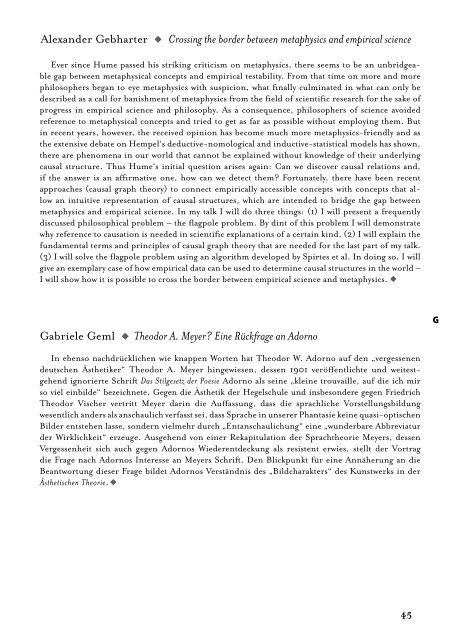Verlag.Buchhandel.Service. - Österreichische Gesellschaft für ...
Verlag.Buchhandel.Service. - Österreichische Gesellschaft für ...
Verlag.Buchhandel.Service. - Österreichische Gesellschaft für ...
Sie wollen auch ein ePaper? Erhöhen Sie die Reichweite Ihrer Titel.
YUMPU macht aus Druck-PDFs automatisch weboptimierte ePaper, die Google liebt.
Alexander Gebharter ◆ Crossing the border between metaphysics and empirical science<br />
Ever since Hume passed his striking criticism on metaphysics, there seems to be an unbridgeable<br />
gap between metaphysical concepts and empirical testability. From that time on more and more<br />
philosophers began to eye metaphysics with suspicion, what finally culminated in what can only be<br />
described as a call for banishment of metaphysics from the field of scientific research for the sake of<br />
progress in empirical science and philosophy. As a consequence, philosophers of science avoided<br />
reference to metaphysical concepts and tried to get as far as possible without employing them. But<br />
in recent years, however, the received opinion has become much more metaphysics-friendly and as<br />
the extensive debate on Hempel‘s deductive-nomological and inductive-statistical models has shown,<br />
there are phenomena in our world that cannot be explained without knowledge of their underlying<br />
causal structure. Thus Hume‘s initial question arises again: Can we discover causal relations and,<br />
if the answer is an affirmative one, how can we detect them? Fortunately, there have been recent<br />
approaches (causal graph theory) to connect empirically accessible concepts with concepts that allow<br />
an intuitive representation of causal structures, which are intended to bridge the gap between<br />
metaphysics and empirical science. In my talk I will do three things: (1) I will present a frequently<br />
discussed philosophical problem – the flagpole problem. By dint of this problem I will demonstrate<br />
why reference to causation is needed in scientific explanations of a certain kind. (2) I will explain the<br />
fundamental terms and principles of causal graph theory that are needed for the last part of my talk.<br />
(3) I will solve the flagpole problem using an algorithm developed by Spirtes et al. In doing so, I will<br />
give an exemplary case of how empirical data can be used to determine causal structures in the world –<br />
I will show how it is possible to cross the border between empirical science and metaphysics. ◆<br />
Gabriele Geml ◆ Theodor A. Meyer? Eine Rückfrage an Adorno<br />
In ebenso nachdrücklichen wie knappen Worten hat Theodor W. Adorno auf den „vergessenen<br />
deutschen Ästhetiker“ Theodor A. Meyer hingewiesen, dessen 1901 veröffentlichte und weitestgehend<br />
ignorierte Schrift Das Stilgesetz der Poesie Adorno als seine „kleine trouvaille, auf die ich mir<br />
so viel einbilde“ bezeichnete. Gegen die Ästhetik der Hegelschule und insbesondere gegen Friedrich<br />
Theodor Vischer vertritt Meyer darin die Auffassung, dass die sprachliche Vorstellungsbildung<br />
wesentlich anders als anschaulich verfasst sei, dass Sprache in unserer Phantasie keine quasi-optischen<br />
Bilder entstehen lasse, sondern vielmehr durch „Entanschaulichung“ eine „wunderbare Abbreviatur<br />
der Wirklichkeit“ erzeuge. Ausgehend von einer Rekapitulation der Sprachtheorie Meyers, dessen<br />
Vergessenheit sich auch gegen Adornos Wiederentdeckung als resistent erwies, stellt der Vortrag<br />
die Frage nach Adornos Interesse an Meyers Schrift. Den Blickpunkt <strong>für</strong> eine Annäherung an die<br />
Beantwortung dieser Frage bildet Adornos Verständnis des „Bildcharakters“ des Kunstwerks in der<br />
Ästhetischen Theorie. ◆<br />
45<br />
G


